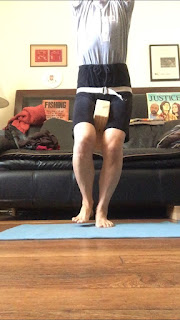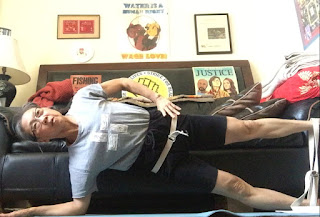Many questions have recently come up from folks experiencing pain in the region of the sacrum, low back, and/or outer hip. Current events, including skyrocketing COVID19 rates, may be contributing to the instability many feel. We all may need to step up our grounding, centering, stabilizing practices in the face of so much suffering and uncertainty.
I've had intermittent SI issues for some years, especially early in my practice. The issue seemed to resolve itself as my practice became more balanced and mature. However, since menopause, and some accompanying loss of strength and muscle, some of the sacral and hip issues have returned. At least once a week, I concentrate on strengthening and stabilizing this region, and the sequence I've developed through lots of exploration, research, and trial and error, has been helping a ton. I hope it helps you too.
The wonderful, classic Tadasana with a sacral strap and block. Here, the strap is at the level of the pubis and horizontal center of sacrum. It can also be taken a little lower, toward the greater trochanter/outer hip. It's also wonderful to wear more than one strap: 2 or 3 at varying levels can be incredibly helpful. The strap/s should provide immediate relief from discomfort, and can be worn all day, while you drive, or whenever. Place the buckle at center front, so it doesn't dig into your skin, and you can easily adjust it. It should be VERY snug. The block is not a requirement, but is helpful in doing the next asana. You could add another strap below the block if you wish.Tadasana variation: Here I am shifting my weight to one leg. Try not to bend to the side or forward, but to make the weight shift subtle and slow and only until the other leg becomes light and the foot just barely leaves the floor. The standing leg will be working hard, and the gluteals, especially the medias and minimus, firmly engaged. The lifted leg and its glutes will also be engaged. Do both sides to correct asymmetries.
Here I am doing the same weight shift I did in Tadasana. Ekapada Utkatasana is quite challenging and will ask a lot of the legs and hip muscles to maintain symmetry. In other words, don't let the standing leg outer hip bulge out. In all poses, the work is to keep the femur heads deeply engaged.
From a narrow Utthita Hasta Padasana (not pictured), I apply the same concept of leaning from side to side. The strap is not absolutely necessary but will intensify the work of the pose and the training of the muscles. You can also use a resistance band if you have one. In either case, the lifted leg needs to stay facing forward while abducting and pushing OUT into the strap. The standing leg, as always, should be stabilizing the femur deep in the hip socket. The intensity can be adjusted by the distance between the feet: the further apart they are, the more difficult the pose. Make sure the gluteas medias and minimus are fully engaged on both sides.
Vasisthasana variations: Here I have to work hard in the lower hip to grip the femur in. I can intensify the challenge by abducting the top leg, as in Utthita Hasta Padasana (no rotation), and challenge further by using a strap or band and pushing out into it. Resist the temptation to do the work from your abdominal strength, and instead redirect the effort into the legs and hips.
Coming down onto the forearm brings the body more parallel to the floor and increases the challenge. Even more intense (not pictured) is having the feet on a chair and the hand on the floor.











2 comments:
Thank you Gwi-Seok, I will add this to my mix of activity! I'm so happy to have stumbled upon your blog and will be a return reader!
Great sequence. You seem like a very sweet person. Thank you so much!
Post a Comment